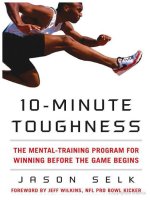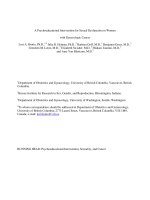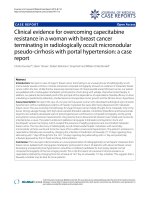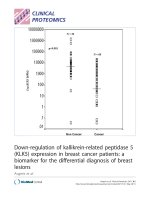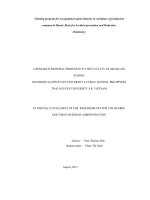A consultation training program for physicians for communication about complementary medicine with breast cancer patients: A prospective, multi-center, cluster-randomized, mixed-method
Bạn đang xem bản rút gọn của tài liệu. Xem và tải ngay bản đầy đủ của tài liệu tại đây (684.52 KB, 8 trang )
Blödt et al. BMC Cancer (2016) 16:843
DOI 10.1186/s12885-016-2884-y
RESEARCH ARTICLE
Open Access
A consultation training program for
physicians for communication about
complementary medicine with breast
cancer patients: a prospective, multi-center,
cluster-randomized, mixed-method pilot
study
Susanne Blödt1, Nadine Mittring1, Lena Schützler1, Felix Fischer1,2, Christine Holmberg3, Markus Horneber4,
Adele Stapf4 and Claudia M. Witt1,5*
Abstract
Background: The aim was to develop and evaluate a training program for physicians for communicating with
breast cancer patients about complementary medicine (CM).
Methods: In a cluster-randomized pilot trial eight breast cancer centers (two physicians per center) were
randomized to either a complementary communication training program (9 h e-learning + 20 h on-site skills
training) or to a control group without training. Each physician was asked to consult ten patients for whom he or
she is not the physician in charge. We used mixed methods: Quantitative outcomes included physicians’
assessments (empathy, complexity of consultation, knowledge transfer) and patients’ assessments (satisfaction,
empathy, knowledge transfer). For qualitative analyses, 15 (eight in the training and seven in the control group)
videotaped consultations were analyzed based on grounded theory, and separate focus groups with the physicians
of both groups were conducted.
Results: A total of 137 patients were included. Although cluster-randomized, physicians in the two groups differed.
Those in the training group were younger (33.4 ± 8.9 vs. 40.0 ± 8.5 years) and had less work experience (5.4 ± 8.9 vs.
11.1 ± 7.4 years). Patient satisfaction with the CM consultation was relatively high on a scale from 0 to 24 and was
comparable in the two groups (training group: 19.4 ± 4.6; control group 20.5 ± 4.1). The qualitative findings showed
that physicians structured majority of consultations as taught during the training. Comparing only the younger and
less CM experienced physicians, those trained in CM communication felt more confident discussing CM-related
topics than those without training.
Conclusion: A CM communication-training program might be especially beneficial for physicians with less
consulting experience when communicating about CM-related issues. A larger trial using more suitable quantitative
outcomes needs to confirm this.
(Continued on next page)
* Correspondence:
1
Institute for Social Medicine, Epidemiology and Health Economics, Charité Universitätsmedizin Berlin, Luisenstrasse 57, 10117 Berlin, Germany
5
Institute for Complementary and Integrative Medicine, University of Zurich
and University Hospital Zurich, Zurich, Switzerland
Full list of author information is available at the end of the article
© The Author(s). 2016 Open Access This article is distributed under the terms of the Creative Commons Attribution 4.0
International License ( which permits unrestricted use, distribution, and
reproduction in any medium, provided you give appropriate credit to the original author(s) and the source, provide a link to
the Creative Commons license, and indicate if changes were made. The Creative Commons Public Domain Dedication waiver
( applies to the data made available in this article, unless otherwise stated.
Blödt et al. BMC Cancer (2016) 16:843
Page 2 of 8
(Continued from previous page)
Trial registration: ClinicalTrials.gov: NCT02223091, date of registration: 7 February 2014.
Keywords: Communication, Breast cancer, Complementary and integrative medicine
Key message
A complementary medicine communication-training
program might be especially beneficial for younger physicians with less experience in communicating with cancer patients about complementary medicine.
Background
Half of the cancer patients use CM [1]. The European Society of Breast Cancer Specialists has recognized CM as
relevant topic [2] and it is increasingly integrated into cancer care as integrative medicine. Clinical practice guidelines for integrative medicine have been drawn up [3].
Although breast cancer patients wish to receive information about CM from the specialist they consult [4, 5], it is
rarely a topic of patient-physician communication [4, 6]
with specialists being less often informed by their patients
about CM use than general practitioners (GPs) [4]. Reasons for not disclosing CM use include a lack of confidence in the physicians’ openness towards the topic, a lack
of trust in physician’s CM expertise, and a perception that
there is insufficient time to discuss it [4, 7, 8]. Consequently, patients often seek information outside the medical system with an increasing risk of interactions between
herbs and anticancer therapies [9]. Physicians often feel
uncomfortable discussing CM-related questions and seek
training on CM [10]. Besides presenting evidence-based
information on CM, guidelines highlight the importance of teaching communication skills [11], since effective communication can positively affect outcomes
such as patient satisfaction and quality of life [12, 13]. Although first CM-related trainings are available, a
training that focusses on communicating CM and
uses a blended learning approach is still missing. This
study was part of a collaborative research project,
Competence Network Complementary Medicine in
Oncology – KOKON, whose aim was to improve
evidence-based knowledge on CM among patients
and health professionals. The aim was to develop and
evaluate a blended-learning training program for physicians for communicating with breast cancer patients
about CM. Its feasibility and preliminary effects were
evaluated by using quantitative and qualitative research methods (mixed-method approach).
Methods
Design
In a prospective multicenter cluster-randomized pragmatic mixed-method pilot trial we compared a group of
trained physicians with an untrained group (control).
The study design has been developed with a stakeholder
group using Delphi methods (one meeting plus written
rounds) including patient representatives, oncologists,
psychologists, an expert in media science, an ethicist,
GPs and CM experts. A total of eight breast cancer centers or Comprehensive Cancer Centers (CCC) with two
physicians each were randomized (Fig. 1). Ten consultations per physician (160 patients in total) were planned.
Each consultation was assessed quantitatively by physicians and patients. For the qualitative analysis 16 consultations (eight in each group) were planned to be
videotaped and focus group discussions with physicians
of both groups were conducted. The study followed the
usual guidelines for clinical trials (Declaration of
Helsinki and ICH-GCP where appropriate), was approved by the respective Ethics Committees (approval
numbers see declaration section) and was registered at
ClinicalTrials.gov: NCT02223091. The directors of the
participating centers, the physicians and the patients
gave written consent to participate in the study.
Participants
Breast Centers or Comprehensive Cancer Centers in
which two physicians were interested in the training
were eligible. Inclusion criteria for physicians were: possibility to conduct consultations during working hours,
possibility to take part in the on-site skills training in
Berlin, not being the physician in charge of the consulted patients and informed consent. Patients were recruited by each of the participating centers by means of
information materials or direct patient-physician contact. Patients were eligible if they met the following criteria: age ≥18 years, female, diagnosed with breast
cancer, being a patient in the participating center, good
German language skills, informed consent.
Intervention and control
The eight physicians in the intervention group (four centers) received the blended learning KOKON CM training
(for content see Table 1) which was developed based 1)
on evidence-based CM communication guidelines [11],
2) the consultation handbook that was systematically developed in KOKON and that includes a theoretical
model and real-life examples, and 3) didactical methods
used in communication and interaction trainings at the
Charité – Universitätsmedizin Berlin. Physicians of the
control group conducted the consultations based on
Blödt et al. BMC Cancer (2016) 16:843
Page 3 of 8
Fig. 1 Study design
prior knowledge and professional experience and received the training after the end of the study.
Randomization
Centers were randomized using a simple cluster
randomization (centers as clusters with two associated
physicians as randomization unit) with an allocation
ratio of 1:1. The randomization list was compiled
from an independent statistician with the program
SAS (version 9.3, SAS Inc. Cary, NC, USA). The centers were allocated in order of the receipt of the informed consent by an independent employee of the
Institute for Social Medicine, Epidemiology and
Health Economics who was not otherwise involved in
the study. The study team had no access to the
randomization list.
Quantitative outcome measurements
We collected the physicians’ socio-demographic and
professional data at baseline. After each consultation the
physician completed a self-assessment about the consultation (general suitability, empathy, structure, complexity
and knowledge transfer).
Patients’ outcome measurements after the consultation
used adapted versions of the German Consultation and
Relational Empathy questionnaire (CARE) [14], German
Rating Scales for the Assessment of Empathic Communication in Medical Interviews (REM) [15], questionnaire on satisfaction with inpatient clinical care [16] and
a self-developed scale on knowledge transfer and information. The scale consists of 7 items with 5 response
options each. (Scored from 0 to 4, range of score 0 to
28, higher values indicate better comprehensibility and
Table 1 Training curriculum
Didactical elements
Main objectives/content
Size
Consultation Handbook
• Concept of KOKON
consultation
• Examples from real life
consultations
• Acquaintance with key elements of the KOKON consultation (1. realizing and prioritizing the needs
and concerns of the patient, 2. strategies to communicate relevant information, 3. evidence about
relevant CM-therapies, 4. summary and perspective at the end of the consultation).
• Evidence-based information on nutrition, and physical activity for cancer patients.
• Most common symptoms and typical patient concerns.
84 pages
e-learning
• Reviews
• CAMa summaries in
German
• Consultation videos
• Description of main CM therapies for breast cancer patients (acupuncture, coenzyme 10, ginseng
and yoga).
• Description of most common consultation situations: demand for general information on available
CM therapies, information on specific CM therapies and on CM therapy as alternative for
conventional medicine.
9h
On-site skills training
• Ability to apply KOKON consultation elements in daily practice (Recognize the demand of the
• Role plays with
patient, prioritize, deal with unclear CM evidence and unserious therapies, further procedure).
participants
• Use of KOKONBase (database on CM treatments).
• Exercises with data base • Evidence on hormone therapy, mistletoe and cancer related fatigue.
• Role plays with
simulation patients
• CM expert presentations
a
Complementary and Alternative Medicine for Cancer
20 lectures
(45 min each)
Blödt et al. BMC Cancer (2016) 16:843
higher relevance of information given during the consultation). Furthermore we collected patients’ sociodemographic data.
Page 4 of 8
Baseline characteristic of patients
Patients in the training group were slightly older (mean
age: 52.9 ± 11.7 versus 51.3 ± 13.6 years) and better educated (49 % more than 12 years of school education versus 39 %) compared to those in the control group.
Statistics
Data analysis was conducted by descriptive methods.
Continuous variables are presented as means, standard
deviations, medians and in parts as ranges, categorical
variables as absolute and relative frequencies. Satisfaction, empathy and information scores were each modeled in a mixed-effect regression, with intervention as a
fixed effect and the physician as a random effect. These
models were than extended to calculate the mean differences among the participating physicians, adjusting for
age, experience and position (junior physician, specialist,
senior physician). Because this is an exploratory analysis
we report estimated means and 95 % confidence
intervals.
Qualitative data collection and analysis
Video recordings were taken within the study, and their
analysis was based on grounded theory [17, 18]. A content log for summarizing the communication process
and setting the interactions and developing initial coding
strategies for analysis was done in a group setting by
CH + NM. Content logs were coded and analyzed using
MAXQDA.
The focus groups were conducted by a trained moderator who was not otherwise involved in the study and
followed a semi-structured interview guideline. The
guideline was based on the video analysis and included
questions about the training, suggestions for improvement, experience with the consultations, the concept,
the expectations of the physician toward the consultation, and the manner in which a lack of information
about CM was dealt with during the consultation.
The responses of both focus groups were audiorecorded, transcribed verbatim and analyzed using qualitative content analysis [19] with MAXQDA. The discussion
of the control and training group were analyzed separately, after which the results were compared.
Results
Quantitative results
Baseline characteristic of physicians
Of 54 invited centers, 35 were not interested, 11 did not
meet the inclusion criteria and eight participated. Although cluster-randomization was conducted physicians’
baseline characteristics differed, with physicians in the
control group being more experienced in CM and older
(Table 2).
Feasibility and primary quantitative results
In total, 137 patients had consultations between
September 2014 and February 2015 (median number
of consultations: intervention group = 10, control
group = 7). In the control group one physician took
maternal leave and was replaced. The mean consultation duration was 46.5 ± 26.3 min in the training and
29.4 ± 13.4 min in the control group.
Patient satisfaction with the CM consultation was relatively high in both groups (training group: 19.4 ± 4.6;
control group 20.5 ± 4.1 on a scale from 0 to 24). After
adjustment for age, experience and position the training
group had slightly better results for some of the outcomes (Fig. 2). Except one, all the physicians in both
groups perceived the consultation setting as suitable and
perceived the consultation as positive (Table 3). This
one physician did not provide further explanation why
the consultation setting wasn’t suitable for him.
Qualitative results
Sample description
Fifteen consultations (8 in the training and 7 in the control group, the 8th video consultation in the control
group had been cancelled due to maternal leave of the
physician) by eight physicians were video-recorded.
Three physicians per group considered themselves inexperienced in CM.
Characteristics of the consultation sessions
The content of the consultation depended on the stage
of the patients’ disease. With newly diagnosed patients
the focus was on informing the patients about possible
CM treatment options and giving dietary and exercise
recommendations. With patients during/after treatment
or in the case of metastatic disease consultations targeted specific needs.
The consultations were not only used to discuss CM.
The patients also used the time with a physician to address other issues (e.g. anxiety about the cancer itself,
concerns regarding chemotherapy).
In the training group the KOKON consultation elements (Table 1) were applied in most of the observed
consultations. By contrast, these elements were less
often applied by the untrained physicians.
Focus group discussion
Five of eight physicians from each group participated.
Blödt et al. BMC Cancer (2016) 16:843
Page 5 of 8
Table 2 Baseline physicians’ characteristics
Training group (n = 8)
/
Control group (n = 9)
mean ± sda/
mean ± sda
median
range
mean ± sda
median
range
Number of consultation
10.0 ± 0.0
10
10–10
6.3 ± 4.0
7
1–10
Age
33.4 ± 8.9
30.5
27–55
40.0 ± 8.5
37.0
31–55
Years of professional experience in consultation of cancer patients
5.4 ± 8.9
2.5
0.5–27
11.1 ± 7.4
9.0
4–24
n (%)
n (%)
Female gender
7 (87.5 %)
9 (100 %)
Medical specialist
2 (25.0 %)
7 (77.8 %)
Oncologist
Completed
0 (0 %)
4 (44.4 %)
Envisaged
2 (25.0 %)
2 (22.2 %)
Completed
2 (25.0 %)
5 (55.6 %)
Envisaged
5 (62.5 %)
1 (11.1 %)
Completed
0 (0 %)
1 (11.1 %)
Envisaged
0 (0 %)
1 (11.1 %)
2 (25.0 %)
3 (33.3 %)
I completely disagree
0 (0 %)
0 (0 %)
I rather disagree
0 (0 %)
0 (0 %)
I rather agree
3 (37.5 %)
1 (11.1 %)
I completely agree
5 (62.5 %)
8 (88.9 %)
I completely disagree
2 (25.0 %)
2 (22.2 %)
I rather disagree
5 (62.5 %)
4 (44.4 %)
I rather agree
1 (12.5 %)
2 (22.2 %)
I completely agree
0 (0 %)
1 (11.1 %)
I completely disagree
1 (12.5 %)
4 (44.4 %)
I rather disagree
4 (50.0 %)
5 (55.6 %)
I rather agree
3 (37.5 %)
0 (0 %)
I completely agree
0 (0 %)
0 (0 %)
I completely disagree
4 (50.0 %)
4 (44.4 %)
I rather disagree
3 (37.5 %)
4 (44.4 %)
I rather agree
1 (12.5 %)
1 (11.1 %)
I completely agree
0 (0 %)
0 (0 %)
Gynecologist
Other
Experience in CM consultation (yes)
Self assessment: “Important to be informed about CM”
Self assessment: “I feel confident in a conversation about CM”
Self assessment: “Avoid conversation about CM”
Self-assessment: “I wish patients would deal less with CM”
a
standard deviation
Training group
Overall, participants felt comfortable with applying the
KOKON consultation structure. They were motivated to
conduct high-quality consultations and had the impression that they take more time for consultations than
before the training. In particular, physicians in the early
stage of their career and who had little experience with
CM felt more comfortable consulting on CM and better
prepared to deal with gaps in knowledge about CM
evidence.
Blödt et al. BMC Cancer (2016) 16:843
Page 6 of 8
Fig. 2 Patients’ assessment of the consultation for satisfaction, empathy and knowledge
Discussants also expressed interest in further training
on CM evidence and in group sessions for a literature
review of CM. Some physicians suggested setting up a
CM support hotline for complex cases.
Discussants observed that the topics that came up during consultation were not just related to CM; patients
often had questions about their conventional therapies.
Another point of discussion was the difficulty of integrating CM consultations into clinical routine due to the
amount of time needed.
Control group
The physicians in the control group felt unprepared for
the consultations. This was especially a problem for
Table 3 Self-assessment of each consultation by the physicians (6-point numeric rating scale, 1 (*very good/#very high), 6
(*not at all/#very low))
Item
Training group (n = 8)
mean ± sd/median
/n (%)
Control group (n = 9)
mean ± sd/median
/n (%)
Number of consultation
80 (58.4 %)
57 (41.6 %)
Overall, consultation situation was suitable
(How suitable was the consultation situation to address essential matters?)
79 (98.8 %)
57 (100.0 %)
Empathy (“How well did you succeed in empathizing the patients’ situation
and to take this into account during the consultation?)*
1.7 ± 0.5/2.0
1.9 ± 0.7/2.0
Structure (“How well did you succeed in structuring context, content, setting
and comprehensiveness of the consultation?)*
2.1 ± 0.8/2.0
1.9 ± 0.8/2.0
Information transfer (“How well did you succeed to impart the information?”)*
2.1 ± 0.9/2.0
2.1 ± 0.7/2.0
Understanding (“How sophisticated was the communication with the patient?”)*
1.6 ± 0.9/1.0
1.6 ± 0.8/1.0
Satisfaction with consultation (“Overall, how satisfied were you with the consultation”) *
2.0 ± 1.0/2.0
2.1 ± 0.8/2.0
Complexity of the consultation (“How complex was the consultation?”)#
2.6 ± 1.3/2.0
2.5 ± 1.0/3.0
Blödt et al. BMC Cancer (2016) 16:843
those at an early stage of their career or with no CM
knowledge. To compensate for their lack of knowledge
these physicians prepared themselves by searching for
information on CM. However, they remained insecure
during the consultation.
Physicians found it very satisfying to have a protected
time to talk with their patients. Besides CM other questions concerning the disease in general were discussed.
Like their trained colleagues, physicians in the control
group, especially those at an early stage of their career,
talked about difficulties integrating the consultations
into their daily routines.
Discussion
To our knowledge, this is the first systematic CM
communication-training program and the physicians
judged it positively. The qualitative results showed that a
CM communication-training program might be especially beneficial for physicians with less consulting experience when communicating about CM-related issues.
Many cancer patients wish to be informed about CM
by their physicians [4] and the lack of training in the
field poses a problem. The combination of various pedagogic elements as provided in our training can enhance
satisfaction, learning speed and knowledge of trainees
[20, 21]. In addition our curriculum was evidence and
experience based.
Patients evaluated the consultation service in both
groups very positively and appreciated talking about
CM. The consultations provided a setting in which to
discuss problems and concerns regarding their disease
and treatment effects irrespective of CM.
With regard to quantitative outcomes there were no
differences between the groups. Ceiling effects of the
outcomes and longer consultation experience of the physicians in the control group might explain these results
and more suitable outcomes should be considered in future trials.
However, the training might be especially beneficial
for physicians who are young and have less CM experience. Those reported in the focus groups that
they felt more secure after the training. This provides
information for the ongoing discussion of which
group of physicians would benefit most from such a
training [22].
Physician in the training group took more time for
their consultations compared to those in the control
group, most likely because the scope of the consultation was broader for the training group and those
physicians gave more consideration to their patient’s
situation.
Some physicians obtained information on CM on their
own in order to prepare for their consultations. Although information is available on the internet this did
Page 7 of 8
not help them to overcome feelings of insecurity when
consulting on CM. This highlights the importance of
communication skills beyond simple having facts to
share in CM consultations, e.g. to understand the patient’s individual motivation about CM treatments.
Beside organizational reasons, insecurity in conducting
consultations about CM might have resulted in fewer
consultations being held in the control group compared
to those in the training group.
The strength of the current study was the mixedmethod approach, which provided us with a broad view
of the preliminary effects of CM communication training, its acceptance and its implementation into clinical
routine care.
Communication skills training in oncology showed
small effects for interventions lasting <3 days [22]. Although we tried to balance the shorter duration of the
on-site skills training with blended learning elements
prolonged on-site skill training might have resulted in
larger effects. This was in line with the participants desire to have a longer on-site skills training, but might
not be feasible for most clinicians.
The main limitation of the study is that despite cluster
randomization the physicians of the control group were
older and more experienced in consulting oncological
patients. Especially when the number of clusters is small
– as it is the case in pilot trials – an unequal distribution
of clusters can occur [23]. Randomization at the patient
level might have prevented unequal distribution, but this
is not practical for a training program as an intervention,
because knowledge exchange among the physicians in
one hospital is highly probable, and might influence the
results.
The participating physicians found it difficult to integrate the CM consultations into their daily routine as
the consultations were time-intensive. Moreover, the
training was directed to inform patients about CM in an
independent consultation with a physician who is not in
charge of the patient. A training program that focused
on informing a physician’s own patients about CM might
be less time-consuming and easier to implement into
daily routine.
Conclusion
Our results suggest that patients appreciated consultations about CM. Young and inexperienced physicians
might derive a greater benefit from training on communicating with patients about CM, because their
more experienced colleagues may have gained CM
knowledge independently during their career. For future studies it is important to develop appropriate
outcome measures and to assure comparability of
groups.
Blödt et al. BMC Cancer (2016) 16:843
Abbreviations
CAM: Complementary and alternative medicine; CM: Complementary
medicine; GP: General practitioner
Acknowledgements
We thank Iris Bartsch for data acquisition and Katja Icke for data
management as well as the stakeholders (H. H. Bartsch, M. Grimm, C. Güthlin,
J. Hauer, S. Joos, H. Lampe, C. Lampert, K. Meißler, M. Rostock, J. Schildmann,
J. Weis) for their advise on the study design. We also thank the participating
physicians from the Charité - Universitätsmedizin Berlin, DRK Clinic Westend,
Sana Clinic Lichtenberg, Vivantes Clinic am Urban, University Hospital
Würzburg, Clinical Center Nuremberg, Klinikum Nord Nürnberg, Clinical
Center of the Ludwig-Maximilians-University (LMU) Munich, University Hospital
Heidelberg.
Page 8 of 8
4.
5.
6.
7.
Funding
Deutsche Krebshilfe (German Cancer Aid) grant 109863.
8.
Availability of data and materials
Data are available on request.
9.
10.
Authors’ contributions
Conceived and designed the study: CH, CMW, MH. Development of the
curriculum: AS, CMW, FF, LS, MH, NM. Data analysis and interpretation: CH,
CMW, FF, NM, SB. Wrote the first draft of the manuscript: SB. All authors
discussed the results, commented on the manuscript, and approved the final
manuscript.
11.
12.
Competing interests
The authors declare that they have no competing interests.
13.
Consent for publication
Not applicable due to pseudonymized data.
Ethics approval and consent to participate
The study followed the usual guidelines for clinical trials (Declaration of
Helsinki, ICH-GCP), was approved by the respective Ethics Committees
(Charité - Universitätsmedizin Berlin (ethical approval number: EA1/093/14 for
Berlin), DRK Clinic Westend, Sana Clinic Lichtenberg, Vivantes Clinic am
Urban, University Hospital Würzburg (ethical approval number 176/14_z),
Clinical Center Nuremberg, Klinikum Nord Nürnberg, Clinical Center of the
Ludwig-Maximilians-University (LMU) Munich, (ethical approval number: 329-14)
University Hospital Heidelberg (ethical approval number: S-420/2014)).
The study was registered at ClinicalTrials.gov: NCT02223091.
Author details
1
Institute for Social Medicine, Epidemiology and Health Economics, Charité Universitätsmedizin Berlin, Luisenstrasse 57, 10117 Berlin, Germany.
2
Department of Psychosomatic Medicine, Center for Internal Medicine and
Dermatology, Charité - Universitätsmedizin Berlin, Berlin, Germany. 3Institute
of Public Health, Charité - Universitätsmedizin Berlin, Berlin, Germany.
4
Department of Internal Medicine, Division of Oncology and Hematology,
Paracelsus Medical University, Klinikum Nuremberg, Nuremberg, Germany.
5
Institute for Complementary and Integrative Medicine, University of Zurich
and University Hospital Zurich, Zurich, Switzerland.
Received: 11 April 2016 Accepted: 25 October 2016
References
1. Horneber M, Bueschel G, Dennert G, Less D, Ritter E, Zwahlen M. How many
cancer patients use complementary and alternative medicine: a systematic
review and metaanalysis. Integr Cancer Ther. 2012;11(3):187–203.
2. Baum M, Cassileth BR, Daniel R, Ernst E, Filshie J, Nagel GA, Horneber
M, Kohn M, Lejeune S, Maher J, et al. The role of complementary and
alternative medicine in the management of early breast cancer:
recommendations of the European Society of Mastology (EUSOMA).
Eur J Cancer. 2006;42(12):1711–4.
3. Greenlee H, Balneaves LG, Carlson LE, Cohen M, Deng G, Hershman D,
Mumber M, Perlmutter J, Seely D, Sen A, et al. Clinical practice guidelines
14.
15.
16.
17.
18.
19.
20.
21.
22.
23.
on the use of integrative therapies as supportive care in patients treated for
breast cancer. J Natl Cancer Inst Monogr. 2014;2014(50):346–58.
Tautz E, Momm F, Hasenburg A, Guethlin C. Use of complementary and
alternative medicine in breast cancer patients and their experiences:
a cross-sectional study. Eur J Cancer. 2012;48(17):3133–9.
Oskay-Ozcelik G, Lehmacher W, Konsgen D, Christ H, Kaufmann M,
Lichtenegger W, Bamberg M, Wallwiener D, Overkamp F, Diedrich K, et al.
Breast cancer patients’ expectations in respect of the physician-patient
relationship and treatment management results of a survey of 617 patients.
Ann Oncol. 2007;18(3):479–84.
Juraskova I, Hegedus L, Butow P, Smith A, Schofield P. Discussing
complementary therapy use with early-stage breast cancer patients:
exploring the communication gap. Integr Cancer Ther. 2010;9(2):168–76.
Huebner J, Muenstedt K, Prott FJ, Stoll C, Micke O, Buentzel J, Muecke R,
Senf B. Online survey of patients with breast cancer on complementary and
alternative medicine. Breast Care (Basel). 2014;9(1):60–3.
Vickers KA, Jolly KB, Greenfield SM. Herbal medicine: women’s views,
knowledge and interaction with doctors: a qualitative study. BMC
Complement Altern Med. 2006;6:40.
Meijerman I, Beijnen JH, Schellens JH. Herb-drug interactions in oncology:
focus on mechanisms of induction. Oncologist. 2006;11(7):742–52.
Corbin Winslow L, Shapiro H. Physicians want education about
complementary and alternative medicine to enhance communication with
their patients. Arch Intern Med. 2002;162(10):1176–81.
Schofield P, Diggens J, Charleson C, Marigliani R, Jefford M. Effectively
discussing complementary and alternative medicine in a conventional
oncology setting: communication recommendations for clinicians.
Patient Educ Couns. 2010;79(2):143–51.
Ong LM, Visser MR, Lammes FB, de Haes JC. Doctor-patient communication
and cancer patients’ quality of life and satisfaction. Patient Educ Couns.
2000;41(2):145–56.
Hilaire DM. The need for communication skills training in oncology.
J Adv Pract Oncol. 2013;4(3):168–71.
Neumann M, Wirtz M, Bollschweiler E, Warm M, Wolf J, Pfaff H. Psychometric
evaluation of the German version of the “Consultation and Relational
Empathy” (CARE) measure at the example of cancer patients. Psychother
Psychosom Med Psychol. 2008;58(1):5–15.
Nicolai J, Demmel R, Hagen J. Rating scales for the assessment of empathic
communication in medical interview (REM): scale development, reliability,
and validity. J Clin Psychol Med Settings. 2007;14(4):367–75.
Kriz D, Schmidt J, Nubling R. The satisfaction of relatives with service
delivery of nursing homes for the elderly. Development of the screeningquestionnaire ZUF-A-7. Pflege. 2006;19(2):88–96.
Glaser BG, Strauss AL. Grounded theory. Strategien qualitativer Forschung.
3rd ed. Bern: Hans Huber; 2010.
Schuber C. Video analysis of practice and the practice of video analysis.
Secting field and focus in videography. In: Knoblauch H, Schnettler B, Raab
J, Soeffner H-G, editors. Video analysis: methodology and methods.
Frankfurt am Main: Peter Lang; 2006. p. 115–26.
Hsieh HF, Shannon SE. Three approaches to qualitative content analysis.
Qual Health Res. 2005;15(9):1277–88.
Sadeghi R, Sedaghat MM, Sha Ahmadi F. Comparison of the effect of
lecture and blended teaching methods on students’ learning and
satisfaction. J Adv Med Educ Prof. 2014;2(4):146–50.
Ferber J, Schneider G, Havlik L, Heuft G, Friederichs H, Schrewe FB, SchulzSteinel A, Burgmer M. [In Process Citation]. Z Psychosom Med Psychother.
2014;60(4):310–323
Barth J, Lannen P. Efficacy of communication skills training courses in
oncology: a systematic review and meta-analysis. Ann Oncol.
2011;22(5):1030–40.
de Hoop E, Teerenstra S, van Gaal BG, Moerbeek M, Borm GF. The “best
balance” allocation led to optimal balance in cluster-controlled trials.
J Clin Epidemiol. 2012;65(2):132–7.
